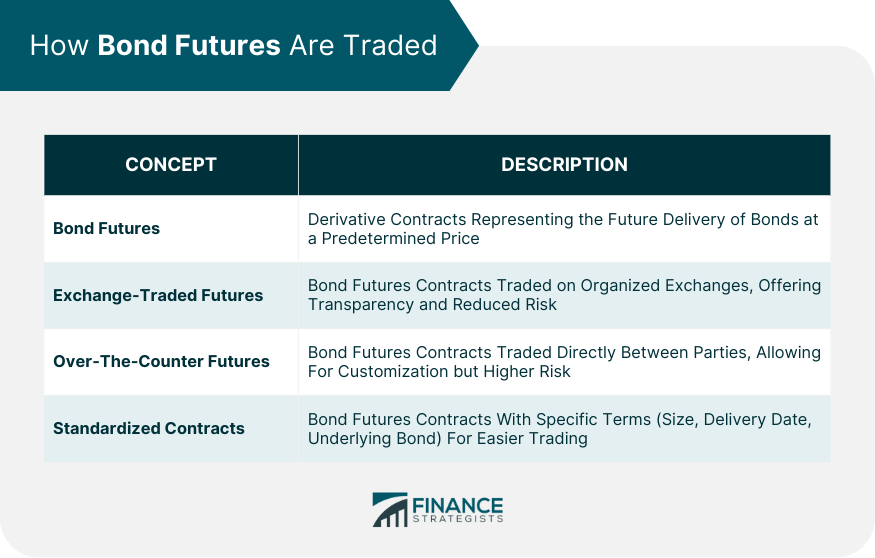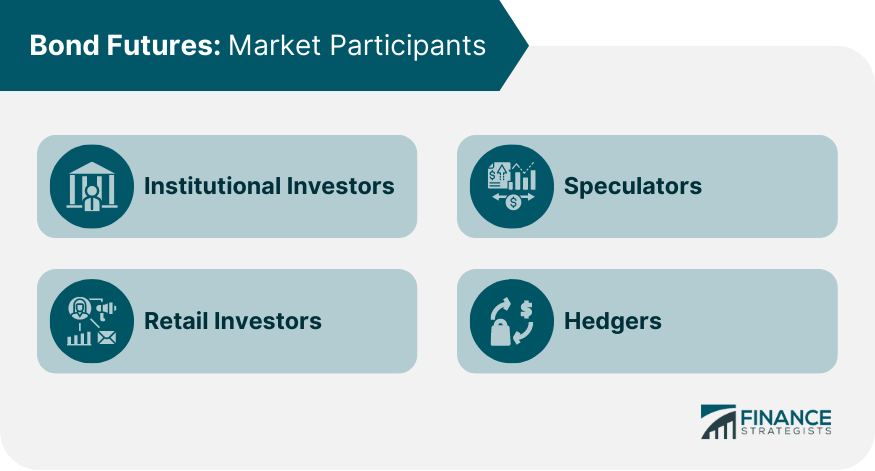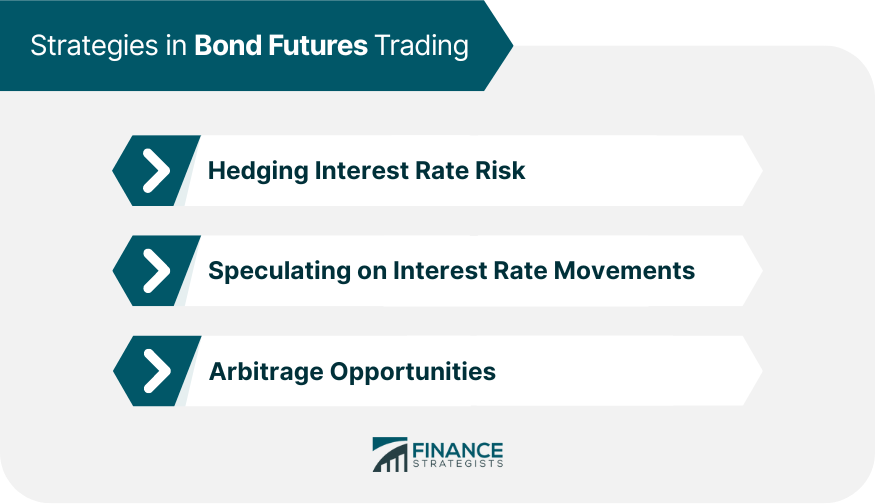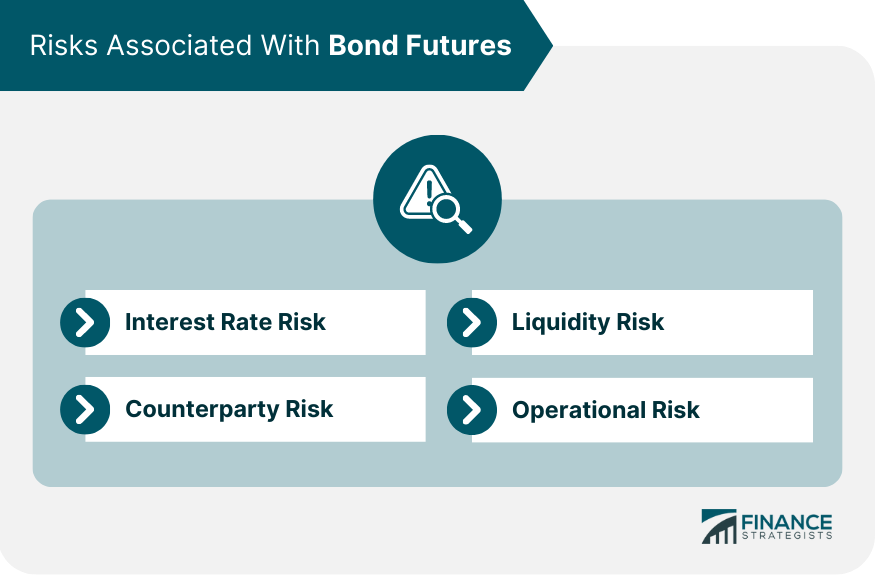Bond futures are financial derivative contracts that obligate the buyer and seller to transact a specified bond at a predetermined price and date. These contracts allow market participants to speculate on or hedge against future interest rate movements. They play a critical role in the financial markets by enabling participants to manage interest rate risk, lock in prices for future bond transactions, and speculate on interest rate movements. They also contribute to price discovery and liquidity in the bond market. Various types of bonds can be used in bond futures contracts, such as government bonds, treasury notes, and corporate bonds. The choice of the underlying bond depends on the specific contract's terms and the market participants' needs and objectives. Bond futures are traded on organized exchanges or over-the-counter (OTC) markets. Exchange-traded bond futures are standardized contracts with specific terms, while OTC bond futures allow for greater customization of contract terms to suit the needs of both parties. Exchange-traded bond futures are traded on regulated exchanges and offer transparency, liquidity, and reduced counterparty risk. On the other hand, OTC bond futures are traded directly between parties, allowing for more flexibility in contract terms but posing higher counterparty risk. Standardized bond futures contracts have specific terms, such as contract size, delivery date, and underlying bond, which facilitates trading and reduces transaction costs. This standardization is essential for creating a liquid and transparent market. Pricing and valuation of bond futures involve understanding the quotation conventions, pricing factors, and conversion factors used in the market. These components help determine the fair value of a bond future contract. Quotation conventions are the standardized way bond futures prices are quoted on exchanges. They typically include the bond's price as a percentage of its face value and an additional fraction representing the accrued interest. Pricing factors that influence bond futures prices include the underlying bond's price, interest rates, time to maturity, and market expectations. These factors help traders and investors assess the bond future's value and make informed decisions. Conversion factors are used to adjust the bond futures price to account for differences in the underlying bonds, such as coupon rates and time to maturity. These factors ensure that bond futures contracts remain comparable and that market participants can trade them effectively. Margin requirements are essential for managing risk in bond futures trading. They include the initial margin, maintenance margin, and margin calls, which ensure that market participants have sufficient capital to cover potential losses. The initial margin is the amount of money a trader must deposit with their broker when opening a bond futures position. This deposit serves as collateral, ensuring that the trader can cover potential losses on the position. The maintenance margin is the minimum amount of equity a trader must maintain in their account while holding a bond futures position. If the trader's account equity falls below this level, they may receive a margin call requiring them to deposit additional funds or close out their position. Margin calls are issued by brokers when a trader's account equity falls below the maintenance margin. Traders must respond to margin calls by either depositing additional funds or liquidating their bond futures positions to cover potential losses. Institutional investors, such as pension funds, mutual funds, and insurance companies, use bond futures to manage interest rate risk and optimize their fixed-income portfolios. They often have significant assets under management and can exert considerable influence on the financial markets. Retail investors are individual investors who trade bond futures for various reasons, such as diversifying their investment portfolios, speculating on interest rate movements, or hedging against interest rate risk. They typically trade smaller contract sizes compared to institutional investors and may have limited access to advanced trading tools and research. Speculators are market participants who trade bond futures with the primary goal of profiting from fluctuations in interest rates. They aim to capitalize on market inefficiencies and short-term price movements, thereby providing liquidity and aiding in price discovery within the bond futures market. Hedgers use bond futures to manage or mitigate their exposure to interest rate risk. They enter into bond futures contracts with the intent of offsetting potential losses in their bond portfolios due to adverse interest rate movements. Hedging interest rate risk is a primary objective of many bond futures market participants. They employ long or short hedges, depending on their interest rate exposure and market outlook. A long hedge involves buying bond futures contracts to protect against the risk of rising interest rates, which could negatively impact the value of a bond portfolio. This strategy is typically employed by investors with a long position in bonds or fixed-income securities. A short hedge involves selling bond futures contracts to protect against the risk of falling interest rates, which could negatively impact the income generated by a bond portfolio. This strategy is typically employed by investors with a short position in bonds or fixed-income securities. Speculators aim to profit from interest rate movements by taking long or short positions in bond futures contracts. Their trading strategies often involve anticipating future interest rate changes and adjusting their positions accordingly. Going long on bond futures involves buying a bond futures contract with the expectation that interest rates will rise, causing the contract's value to increase. Traders who anticipate higher interest rates in the future can profit from this strategy. Going short on bond futures involves selling a bond futures contract with the expectation that interest rates will fall, causing the contract's value to decrease. Traders who anticipate lower interest rates in the future can profit from this strategy. Arbitrage opportunities arise when market inefficiencies cause price discrepancies between related financial instruments. Traders can capitalize on these opportunities by employing cash-and-carry or reverse cash-and-carry arbitrage strategies. Cash-and-carry arbitrage involves simultaneously buying the underlying bond and selling an equivalent bond futures contract when the futures price is higher than the cash price plus carrying costs. This strategy locks in a risk-free profit due to the price discrepancy between the bond and its futures contract. Reverse cash-and-carry arbitrage involves simultaneously selling the underlying bond and buying an equivalent bond futures contract when the futures price is lower than the cash price minus carrying costs. This strategy also locks in a risk-free profit due to the price discrepancy between the bond and its futures contract. Interest rate risk is the potential for bond futures prices to change due to fluctuations in interest rates. This risk can result in losses for bond futures traders if interest rate movements are contrary to their positions. Counterparty risk is the possibility that one party in a bond futures contract will default on their obligations. While exchange-traded bond futures typically have lower counterparty risk due to the presence of clearinghouses, OTC bond futures carry a higher level of risk. Liquidity risk is the risk that a trader may be unable to enter or exit a bond futures position due to a lack of market participants or trading volume. This risk can result in difficulty executing trades at desired prices, leading to potential losses or missed opportunities. Operational risk is the risk of losses arising from inadequate or failed internal processes, systems, or human actions. This risk can affect bond futures trading through issues such as trade execution errors, settlement failures, or technology glitches. Incorporating bond futures into an investment portfolio can provide diversification benefits by spreading risk across various asset classes. Bond futures can help reduce the overall risk of a portfolio and enhance potential returns. Bond futures can be used to adjust a portfolio's asset allocation and maintain target risk levels. By buying or selling bond futures, investors can rebalance their portfolios in response to changing market conditions or investment objectives. Bond futures can be used as benchmarks or performance measurement tools in portfolio management. Comparing a portfolio's returns to bond futures contracts can help identify the sources of performance, such as market timing, security selection, or interest rate exposure. Various regulatory bodies oversee bond futures markets to ensure fair, transparent, and efficient trading. Some of these regulatory authorities include the U.S. Commodity Futures Trading Commission (CFTC), the European Securities and Markets Authority (ESMA), and the Financial Conduct Authority (FCA) in the UK. Bond futures trading is subject to various regulations and rules designed to protect market participants and maintain market integrity. These regulations may include position limits, margin requirements, and reporting obligations, among others Compliance with regulations and transparency in bond futures trading is essential for maintaining investor confidence and ensuring the proper functioning of the market. Adhering to regulatory requirements helps prevent market manipulation, fraud, and systemic risk while promoting fair and efficient trading. Bond futures are derivative contracts that allow market participants to manage interest rate risk, speculate on interest rate movements, and diversify their portfolios. They can be traded on organized exchanges or over-the-counter markets, with exchange-traded futures offering transparency and reduced counterparty risk. Standardized contracts with specific terms facilitate trading and price discovery. Bond futures trading involves various strategies, including hedging, speculating, and arbitrage. However, there are risks associated with bond futures, such as interest rate risk, counterparty risk, liquidity risk, and operational risk. Incorporating bond futures into portfolio management can provide diversification benefits, facilitate asset allocation and rebalancing, and aid in performance measurement. Compliance with regulations and transparency are crucial in bond futures trading to maintain market integrity and investor confidence.What Are Bond Futures?
Trading Bond Futures
How Bond Futures Are Traded
Exchange-Traded vs Over-the-Counter
Standardized Contracts

Pricing and Valuation of Bond Futures
Quotation Conventions
Pricing Factors
Conversion Factors
Margin Requirements
Initial Margin
Maintenance Margin
Margin Calls
Market Participants

Institutional Investors
Retail Investors
Speculators
Hedgers
Strategies in Bond Futures Trading

Hedging Interest Rate Risk
Long Hedge
Short Hedge
Speculating on Interest Rate Movements
Going Long on Bond Futures
Going Short on Bond Futures
Arbitrage Opportunities
Cash-and-Carry Arbitrage
Reverse Cash-and-Carry Arbitrage
Risks Associated With Bond Futures

Interest Rate Risk
Counterparty Risk
Liquidity Risk
Operational Risk
Bond Futures in Portfolio Management
Diversification Benefits
Asset Allocation and Rebalancing
Performance Measurement and Attribution
Regulatory Environment in Bond Futures
Regulatory Bodies Overseeing Bond Futures Markets
Key Regulations and Rules Governing Bond Futures Trading
Importance of Compliance and Transparency in Bond Futures Trading
Final Thoughts
Bond Futures FAQs
Bond futures are financial derivative contracts that obligate the buyer and seller to transact a specified bond at a predetermined price and date. They play a crucial role in financial markets by enabling market participants to manage interest rate risk, speculate on interest rate movements, and achieve portfolio diversification.
The main market participants in bond futures trading include institutional investors, retail investors, speculators, and hedgers. Each participant has different objectives and uses bond futures to manage risk, speculate on interest rate movements, or diversify their investment portfolios.
Common strategies used in bond futures trading include hedging interest rate risk through long or short hedges, speculating on interest rate movements by going long or short on bond futures, and taking advantage of arbitrage opportunities through cash-and-carry or reverse cash-and-carry arbitrage.
Risks associated with bond futures trading include interest rate risk, counterparty risk, liquidity risk, and operational risk. These risks can result in potential losses for traders if market conditions or other factors adversely affect their bond futures positions.
Bond futures are regulated by various regulatory bodies to ensure fair, transparent, and efficient trading. Some of these regulatory authorities include the U.S. Commodity Futures Trading Commission (CFTC), the European Securities and Markets Authority (ESMA), and the Financial Conduct Authority (FCA) in the UK. They enforce key regulations and rules governing bond futures trading, such as position limits, margin requirements, and reporting obligations.
True Tamplin is a published author, public speaker, CEO of UpDigital, and founder of Finance Strategists.
True is a Certified Educator in Personal Finance (CEPF®), author of The Handy Financial Ratios Guide, a member of the Society for Advancing Business Editing and Writing, contributes to his financial education site, Finance Strategists, and has spoken to various financial communities such as the CFA Institute, as well as university students like his Alma mater, Biola University, where he received a bachelor of science in business and data analytics.
To learn more about True, visit his personal website or view his author profiles on Amazon, Nasdaq and Forbes.















